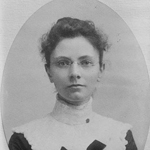
Anne Sewell Young
Anne Sewell Young had the passion for astronomy in her blood--her grandfather, her great-grandfather, and her uncle were all respected Dartmouth astronomers in their own right (even her great-uncle, an architect, designed the Observatory at Dartmouth). It wasn’t long until the curious granddaughter was soon added to that famous lineage. After completing her studies at Carleton College, she was hired as a Mathematics Instructor at Whitman College where she then taught everything from geometry, algebra, analytic geometry, German, elementary rhetoric, mid-prep English, commercial law, and elementary astronomy; she also found time to start a student Astronomical Club. She resigned from the position after a year, and a year after that she started graduate work at Carleton. She spent summers at the Yerkes Observatory, which had then just recently opened, collaborating with J. A. Parkhurst on photometric work. Continuing this summer research for several years, she also became a high school principal in St. Charles Illinois. Just a year after on the job, Young was appointed Head of the Astronomy Department at Mount Holyoke and Director of the college’s observatory in 1889; after several one-year teaching stints, Young held this final post dutifully for 37 years.
Young was known as a kind teacher and a dedicated astronomer. A former student Helen Sawyer Hogg explained, “She impressed me as being devoted to her astronomy students and eager to encourage young women to major in astronomy.” Not very many women were breaking big into Astronomy back then. Within her time at Mount Holyoke, Young designed multiple new courses for the Astronomy curriculum such as an observational course, a course on celestial mechanics, and another on recent developments in astronomy, generally. She began keeping a daily sunspot record in 1900, sending data to Zurich, Switzerland as part of a global research initiative; well into the twenty-first century, such a record is still in progress. In 1902, Young began observing variable stars for E.C. Pickering at the Harvard College Observatory and several years later she took a brief leave of absence at Holyoke and pursued at Ph.D. at Columbia university, creating a catalogue of 145 stars for her dissertation. Back at Mount Holyoke, she held regular public observing sessions, hosted open houses to view Halley’s Comet, and gave lectures to amateur astronomy clubs. In 1911 she became one of the original eight members of the American Association of Variable Star Observers, contributing monthly reports until 1935 and having been elected vice president in both 1919 and 1922. Two of her former students would later become president of the AAVSO. After all of her work at Mount Holyoke, even directed Red Cross work as part of the first world war effort, perhaps Young is best remembered for molding so many budding females astronomers and students who found success well into the twentieth century.
One highlight of her teaching career came on January 24, 1925--a date some readers will recognize as the date of the total solar eclipse that made such a ruckus in Connecticut. The eclipse’s path of totality passed directly over Western Connecticut, right over the Van Vleck Observatory in fact, and Young was determined to get her students a front-seat view. Although she did not return to the Van Vleck Observatory for this occasion (she had visited and signed the guestbook on Dedication Day), Young organized a school-wide field trip to the golf links at Plymouth Meadow Country Club in Windsor, Connecticut for a prime viewing. Fire alarm bells woke up the entire school, including around 800 students, just past 5 in the morning; students and staff were soon filling up special trains to Connecticut. Once on the golf fields, the group climbed to the top of a hill--covered in snow, in -4 degrees weather (degrees in Fahrenheit), to observe the solar eclipse, already in its partial stages, on a clear morning. Young had traveled to see other eclipses, often plagued by cloudy and inclement weather, so she had prepared her students well for disappointment. Instead, students were able to marvel at the natural wonder, trained well on what to observe thanks to their Professor Young, and some even took photographs. Even though the eclipse took place during a week typically dedicated to final exams, no exams were scheduled that day and all attendees received a better treat than A-marks.
When Young retired in 1936, she left the Astronomy department in control of a former student of hers, Alice Farnsworth. Young and her sister moved to Claremont, California where the Professor Emerita spent her days keeping up correspondence with past students and friends, keeping them updated on one another, and also writing a monthly column on astronomy for the Springfield Republican, one of the many ways in which she practiced public outreach. Though she died in 1961, Young left a long and loving legacy for women in astronomy. One of her students, Margaret Wallace, class of 1916, sums up Young’s impact when she said, ““for me, Miss Young was one of the real stars at Mount Holyoke.”
Further resources:
https://www.aavso.org/media/jaavso/2771.pdf
http://adsabs.harvard.edu/full/1962QJRAS...3..355
https://books.google.com/books?id=amtGAwAAQBAJ&lpg=PA410&ots=snGJn9JHrk&dq=Anne%20Sewell%20Young&pg=PA228#v=onepage&q&f=false
The Facts
OccupationHead of Department of Astronomy and Director of John Payson Williston Observatory at Mount Holyoke C
Date & Place of BirthJanuary 02, 1871 in Bloomington, Wisconsin
Date & Place of DeathAugust 15, 1961 in Claremont, California
Alma MaterCarleton College (B.L., M.S.) Columbia University (Ph.D.)
Observatory AffiliationWilliston Observatory
Date of Wesleyan VisitJune 16, 1916 (age 45 at time of visit)